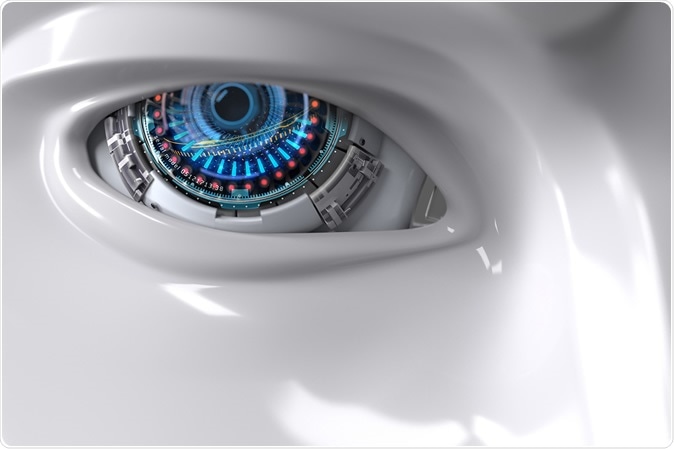Researcher Jayan Thomas says, "This is a baby step toward developing neuromorphic computers, that can simultaneously process and memorize information. At some time in the future, this invention may help to make robots that can think like humans." The big advantage of the current approach is in its saving of energy for processing as well as the time required for computation.

The UCF-developed device is an important step in the fields of AI and robotics.
Sight devices, battles, and drones
Another researcher, Tania Roy, predicted that the new technology might be applied to drones that can fly unaided to remote locations to find people in various dangerous situations. The problem with current drones is, she says, because "These drones need connectivity to remote servers to identify what they scan with their camera eye. Our device makes this drone truly autonomous because it can see just like a human."
With earlier research, scientists succeeded in making a camera that can create an image of what is observed, and then upload it for processing and image recognition to a server. The current device, she says, not only sees the image but also instantly recognizes it.
According to the researchers, this could also be extremely valuable for defense applications, such as helping soldiers see better on a battlefield. Another potential advantage is that, according to the co-first author Sonali Das, "Our device can sense, detect and reconstruct an image along with extremely low power consumption, which makes it capable for long-term deployment in field applications."
Neuromorphic computing
Neuromorphic, or brain-inspired, computing was first described by the scientists Carver Mead towards the second half of the 1980s. He conceived of systems with electronic analog circuits that do not use traditional on/off or binary signaling but instead exchange spurts of electrical impulses with intensities that vary with the stimulation. These so-called very-large-scale integration (VLSI) systems thus work like the neurological circuits in the brain. Such a computer contains multiple simple processors ('neurons') and memory structures ('synapses') that use simple signals to communicate. They are extremely important in and good at computing complex ongoing processes with a small set of simple computational premises.
Neuromorphic engineering has been the dream of many scientists who look forward to designing a computer that can process and store data simultaneously to make vision possible, just as the human brain does. Today, even the best computers process data and store their information in separate locations. This affects their performance in terms of computing speed and doesn't make it possible to offer vision on par with the brain and eyes.
Successful tests
The scientists tested out the device in face recognition experiments. These were only meant to be tests to check out how well the neuromorphic computing helped the machine to see objects. Describing these as preliminary, Thomas says they wanted to assess the optoelectronic device. "Since our device mimics vision-related brain cells, facial recognition is one of the most important tests for our neuromorphic building block."
When they showed the device the pictures of four different people, each time the recognition was correctly achieved.
The superstructure
The achievement rests squarely upon the ability to grow nanosized perovskite quantum dots that respond to light on graphene, a two-dimensional sheet of carbon atoms.
Graphene sheets have a broad spectrum of bandwidths, very high electron mobility, and are an excellent carrier transport, besides outstanding flexibility and stability. However, a fatal flaw is the very low efficiency of charge generation, with only 2% to 3% of incident light being converted to electric charge.
The quantum dots are semiconductors in nanocrystalline form, with bandgaps that can be adjusted across the spectrum of visible light, efficient conversion of light energy from one frequency to another, and other attractive attributes. They have poor charge transport properties, however.
The current superstructure exploits the strengths of both materials while canceling out their weaknesses. Previous attempts to do this have tried to deposit perovskite thin films on graphene, but the present growth technique is novel in optoelectronics. Here, the pi-electron clouds of the perovskite and graphene elements overlap, ensuring an extremely improved charge transfer.
The single-atom thickness of graphene means that the perovskite dots capture the incident light, convert it to electrical charge and transfer this charge straightaway in one seamless flow to the graphene sheet. The whole device is thus a film of about 1/10,000 the thickness of a human hair with the best responsivity and sensitivity in its class of devices.
Photonic synapses and future directions
One of the study's two first authors, Basudev Pradhan, says, "Because of the nature of the superstructure, it shows a light-assisted memory effect. This is similar to humans' vision-related brain cells. The optoelectronic synapses we developed are highly relevant for brain-inspired, neuromorphic computing. This kind of superstructure will definitely lead to new directions in the development of ultrathin optoelectronic devices."
These, therefore, act like photonic synapses, capable of responding to light like a neural network in a way that enables pattern recognition, and therefore the recognition of faces and, in the future, neuromorphic computing. The next step is to continue to refine the device such as making it the base of a system of circuits.
Journal reference:
Ultrasensitive and ultrathin phototransistors and photonic synapses using perovskite quantum dots grown from graphene lattice, Basudev Pradhan, Sonali Das, Jinxin Li, Farzana Chowdhury, Jayesh Cherusseri, Deepak Pandey, Durjoy Dev, Adithi Krishnaprasad, Elizabeth Barrios, Andrew Towers, Andre Gesquiere, Laurene Tetard, Tania Roy and Jayan Thomas, Science Advances 12 Feb 2020: Vol. 6, no. 7, eaay5225 DOI: 10.1126/sciadv.aay5225